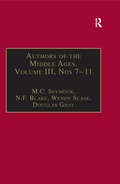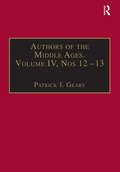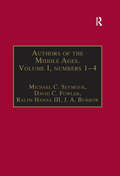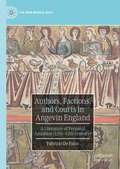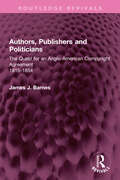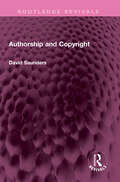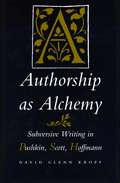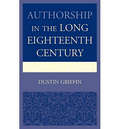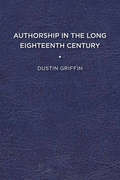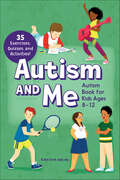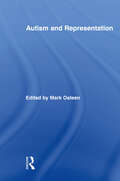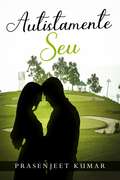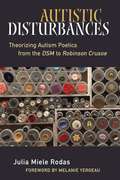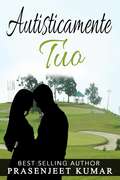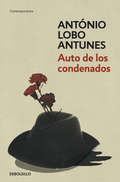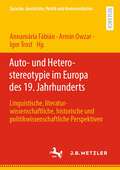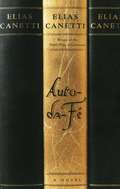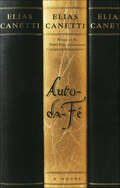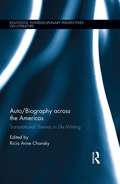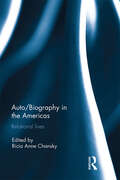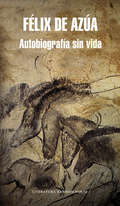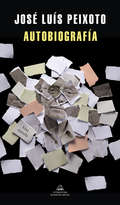- Table View
- List View
Authors of the Middle Ages, Volume III, Nos 7–11: English Writers of the Late Middle Ages (Authors of the Middle Ages)
by Douglas Gray N.F. BlakeAuthors of the Middle Ages is a series designed for research and reference. The aim is to combine, in one compact work, a biography of a medieval author with all the information needed for further research. The series is divided into two sub-series. The first, edited by M.C. Seymour, focuses on EnglishWriters of the Late Middle Ages and the second, edited by Patrick Geary, deals with Historical and Religious Writers of the Latin West. William Caxton was the first English printer and publisher of printed books. He translated many books into English and by the prologues and epilogues added to many of his printed works he helped to establish literary tastes and fashions at the end of the medieval period. The life of Reginald Peacock, bishop, heretic and author, reflects the many controversies of 15th-century England. Drawing on many contemporary sources and based on fresh research. Wendy Scase offers a new interpretation of an enigmatic writer. Douglas Gray traces the lives of the two poets Robert Henryson and William Dunbar. Among the several distinguished poets of late-medieval Scotland. Henryson stands out for his humanity, learned wit and imaginitive power; while Dunbar was one of the most spectacular, flamboyant and versatile Scottish poets of the Middle Ages. This study gives an account of the little that is known of their lives and extensively details both their works and later scholarship. John Capgrave (1393-1464) was an Augustinian friar, Cambridge theologian, hagiographer and chronicler who became Prior Provincial of his order. His life, presented here in the light of fresh research and with full documentation, illuminates the importance of the order in the troubled times of mid 15th-century England.
Authors of the Middle Ages, Volume IV, Nos 12–13: Historical and Religious Writers of the Latin West (Authors of the Middle Ages)
by Patrick J. GearyThe anonymous author who has come to be known as Fredegar put together a collection of historical sources, together with items of his own composing in the second half of the 7th century. His work forms the most important source for the history of France in the period 594 to 642. It was added to in the mid 8th century, in two continuations that provide vital evidence for their own time. Gregory I (590-604) is often considered the first medieval pope; and as fourth doctor of the church, he is the first exponent of a truly medieval spirituality. This book has three parts: a biography concentrates on analyzing Gregory's actions as pope, in the light of spiritual concerns expressed in his literary works; a second section examines individual works and controversies and questions about them, it also provides information about manuscripts and editions; the final section is a select bibliography encompassing the many aspects of Gregorian scholarship.
Authors of the Middle Ages. Volume I, Nos 1–4: English Writers of the Late Middle Ages (Authors of the Middle Ages)
by David C. Fowler J. A. BurrowAuthors of the Middle Ages is a new series designed for research and reference. Each part, by an expert on the subject, gives an account of the facts known about a particular Author’s life and immediate historical context, together with a review of subsequent scholarship. This is supported by citation of all known contemporary references; a dated and classified list of manuscripts and editions; a bibliography of secondary sources; and appendices listing or printing the key literary and documentary sources. The aim is to combine, in one compact work, a bibliography of a medieval author with all the information needed for further research. Each will be available individually, or in a collection with three other contemporary Authors. Authors of the Middle Ages is divided into two sub-series, English Writers of the Late Middle Ages and historical and Religious Writers of the Latin West.
Authors, Audiences, and Old English Verse
by Thomas A. BredehoftAuthors, Audiences, and Old English Verse re-examines the Anglo-Saxon poetic tradition from the eighth to the eleventh centuries and reconsiders the significance of formulaic parallels and the nature of poetic authorship in Old English.Offering a new vision of much of Old English literary history, Thomas A. Bredehoft traces a tradition of 'literate-formulaic' composition in the period and contends that many phrases conventionally considered oral formulas are in fact borrowings or quotations. His identification of previously unrecognized Old English poems and his innovative arguments about the dates, places of composition, influences, and even possible authors for a variety of tenth- and eleventh-century poems illustrate that the failure of scholars to recognize the late Old English verse tradition has seriously hampered our literary understanding of the period. Provocative and bold, Authors, Audiences and Old English Verse has the potential to transform modern understandings of the classical Old English poetic tradition.
Authors, Factions, and Courts in Angevin England: A Literature of Personal Ambition (12th–13th Century) (The New Middle Ages)
by Fabrizio De FalcoAuthors, Factions, and Courts in Angevin England: A Literature of Personal Ambition (12th-13th Century) advances a model for historical study of courtly literature by foregrounding the personal aims, networks, and careers as the impetus for much of the period’s literature. The book takes two authors as case studies – Gerald of Wales and Walter Map – to show how authors not only built their own stories but also used popular narratives and the tools of propaganda to achieve their own, personal goals. The purpose of this study is to overturn the top-down model of political patronage, in which patrons – and particularly royal patrons – set the cultural agenda and dictate literary tastes. Rather, Fabrizio De Falco argues that authors were often representative of many different interests expressed by local groups. To pursue those interests, they targeted specific political factions in the changeable political scenario of Angevin England. Their texts reveal a polycentric view of cultural production and its reception. The study aims to model a heuristic process which is applicable to other courtly texts besides the chosen case-studies.
Authors, Publishers and Politicians: The Quest for an Anglo-American Copyright Agreement, 1815-1854 (Routledge Revivals)
by James J. BarnesFirst published in 1974, Authors, Publishers and Politicians describes the efforts to secure an Anglo-American copyright agreement. It explores the underlying causes of the failure of this quest, a failure which enabled literary pirates on both sides of the Atlantic to continue operations for another forty years. It traces the effects this had on the writers and producers of books as well as their reading public. Few aspects of Anglo-American relations were untouched by the drama presented in this study. Its broader implications range from straightforward business transactions, official diplomatic manoeuvres, endless legal complexities, and clandestine political intrigue to the peculiarities involved in book smuggling, newspaper rivalries and industrial espionage. The book will be of interest to students of legal history, publishing and literature.
Authorship and Copyright (Routledge Revivals)
by David SaundersFirst published in 1992, Authorship and Copyright traces the history of constructions of authorship as a legal reality. It offers an alternative to the two mainstream interpretations that have traditionally been assigned to authorship: the Romantic dialectical ‘birth of the author’ or the language-based post-structuralist ‘death of the author.’ Saunders examines the shortcomings of both schemes by arguing that they impose an arbitrary philosophical direction on the history of authorship and the law of copyright. Saunders addresses the issues relating to copyright and the construction of authorship as a legal status. Combining information and polemic, the author explores such matters as the historical and theoretical relations of copyright and the droit moral, the aestheticization of the law and the juridification of aesthetics, and the argument that authorship as a legal reality is a historically contingent and variable arrangement that cannot be separated from its cultural and juridical context. This book will be of interest to students of law, literature and philosophy.
Authorship and Cultural Identity in Early Greece and China
by Alexander BeecroftIn this book, Alexander Beecroft explores how the earliest poetry in Greece (Homeric epic and lyric) and China (the Canon of Songs) evolved from being local, oral, and anonymous to being textualised, interpreted, and circulated over increasingly wider areas. Beecroft re-examines representations of authorship as found in poetic biographies such as Lives of Homer and the Zuozhuan, and in the works of other philosophical and historical authors like Plato, Aristotle, Herodotus, Confucius, and Sima Qian. Many of these anecdotes and narratives have long been rejected as spurious or motivated by naïve biographical criticism. Beecroft argues that these texts effectively negotiated the tensions between local and pan-cultural audiences. The figure of the author thus served as a catalyst to a sense of shared cultural identity in both the Greek and Chinese worlds. It also facilitated the emergence of both cultures as the bases for cosmopolitan world orders.
Authorship as Alchemy: Subversive Writing in Pushkin, Scott, and Hoffmann
by David Glenn KropfThis book is an attempt to answer Michel Foucault's question, 'What is an author?' It examines the relationship between personal identity, the physical person of the writer, and the 'author' projected as a matter of public perception via the reception of written texts. It approaches this problem by analyzing the way Romantic writers play upon and subvert the 'author' position projected upon them in the public reception of their texts, and it sheds light on the use of anonyms and pseudonyms as strategies that subvert the emerging institution of authorship.
Authorship in the Long Eighteenth Century
by Dustin GriffinThis book deals with changing conditions and conceptions of authorship in the long eighteenth century, a period often said to have witnessed the birth of the modern author. It focuses not on authorial self-presentation or self-revelation but on an author’s interactions with booksellers, collaborators, rivals, correspondents, patrons, and audiences. Challenging older accounts of the development of authorship in the period as well as newer claims about the “public sphere” and the “professional writer,” it engages with recent work on print culture and the history of the book. Methodologically eclectic, it moves from close readings to strategic contextualization. The book is organized both chronologically and topically. Early chapters deal with writers – notably Milton and Dryden – at the beginning of the long eighteenth century, and later chapters focus more on writers — among them Johnson, Gray, and Gibbon — toward its end. Looking beyond the traditional canon, it considers a number of little-known or little-studied writers, including Richard Bentley, Thomas Birch, William Oldys, James Ralph, and Thomas Ruddiman. Some of the essays are organized around a single writer, but most deal with a broad topic – literary collaboration, literary careers, the republic of letters, the alleged rise of the “professional writer,” and the rather different figure of the “author by profession.” Published by University of Delaware Press. Distributed worldwide by Rutgers University Press.
Authorship in the Long Eighteenth Century
by Dustin GriffinThis book deals with changing conditions and conceptions of authorship in the long eighteenth century, a period often said to have witnessed the birth of the modern author. It focuses not on authorial self-presentation or self-revelation but on an author’s interactions with booksellers, collaborators, rivals, correspondents, patrons, and audiences. Challenging older accounts of the development of authorship in the period as well as newer claims about the “public sphere” and the “professional writer,” it engages with recent work on print culture and the history of the book. Methodologically eclectic, it moves from close readings to strategic contextualization. The book is organized both chronologically and topically. Early chapters deal with writers – notably Milton and Dryden – at the beginning of the long eighteenth century, and later chapters focus more on writers — among them Johnson, Gray, and Gibbon — toward its end. Looking beyond the traditional canon, it considers a number of little-known or little-studied writers, including Richard Bentley, Thomas Birch, William Oldys, James Ralph, and Thomas Ruddiman. Some of the essays are organized around a single writer, but most deal with a broad topic – literary collaboration, literary careers, the republic of letters, the alleged rise of the “professional writer,” and the rather different figure of the “author by profession.” Published by University of Delaware Press. Distributed worldwide by Rutgers University Press.
Autism and Me: Autism Book for Kids Ages 8–12
by Katie CookHelp children understand their autism and thrive with this positive guide for kids ages 8 to 12 We all think differently. This notion is celebrated in Autism and Me, a guide that helps children with autism spectrum disorder (ASD) gain a better understanding of how their brain works. The book highlights positive ASD traits while showing kids how they can work through some of its challenges as well.Unlike some other autism books for kids, this guide offers: Awesome activities—Interactive exercises encourage kids to apply the concepts discussed in a fun, low-stakes way, from fill-in-the-blanks and multiple choice quizzes to drawing and coloring.Proven strategies—From improving communication skills to developing self-care habits, kids will find strategies to help them better navigate school, social functions, and family life.True stories—Each chapter begins with real life anecdotes, offering relatable experiences from others on the autism spectrum and helping kids feel less alone.Kids will learn to manage emotions, make friends, and flourish with this strengths-based autism book.
Autism and Representation (Routledge Research in Cultural and Media Studies)
by Mark OsteenAutism, a neuro-developmental disability, has received wide but often sensationalistic treatment in the popular media. A great deal of clinical and medical research has been devoted to autism, but the traditional humanities disciplines and the new field of Disability Studies have yet to explore it. This volume, the first scholarly book on autism in the humanities, brings scholars from several disciplines together with adults on the autism spectrum to investigate the diverse ways that autism has been represented in novels, poems, autobiographies, films, and clinical discourses, and to explore the connections and demarcations between autistic and "neurotypical" creativity. Using an empathetic scholarship that unites professional rigor with experiential knowledge derived from the contributors’ lives with or as autistic people, the essays address such questions as: In what novel forms does autistic creativity appear, and what unusual strengths does it possess? How do autistic representations--whether by or about autistic people--revise conventional ideas of cognition, creativity, language, (dis)ability and sociability? This timely and important collection breaks new ground in literary and film criticism, aesthetics, psychology, and Disability Studies.
Autistamente Seu
by Prasenjeet KumarUma história de amor sem contato visual... O mundo de Dev Singh e Meera Desai é diferente. Ambos são diagnosticados com autismo. E ambos pensam sobre o amor e beleza de formas diferentes. O desafio deles: esquecer o amor; ninguém quer ser amigo deles. Nem na escola. Nem na faculdade. Nem mesmo em seus respectivos trabalhos. Porém, Dev e Meera acreditam que existe alguém especial aguardando por eles. Em algum lugar neste mundo vasto e amplo. Dev usa um terno todos os dias e carrega uma rosa na mão, na esperança de entregá-la a sua pessoa especial, algum dia. Meera prefere passar o tempo com seu melhor amigo—um desenho que ela mesma fez—um homem de terno escuro e um chapéu de mandrágora. Ela acredita que seu melhor amigo é alguém que não irá julgá-la e nunca a deixaria sozinha. O problema: Dev e Meera moram a milhares de quilômetros de distância. Meera em Mumbai; Dev em Kalimpong, uma pequena cidade pitoresca no norte da Bengala Ocidental. Explore a jornada de Dev e Meera enquanto eles viajam pela Índia em busca um do outro. Eles vão se apaixonar? O relacionamento deles sobreviverá às terríveis previsões feitas pelos especialistas? Acompanhe as alegrias, sofrimentos e tristezas sobre como Dev e Meera combatem seus próprios demônios internos em busca de uma solução que possa funcionar. Para eles.
Autistic Disturbances: Theorizing Autism Poetics from the DSM to Robinson Crusoe (Corporealities: Discourses Of Disability)
by Julia M RodasWhile research on autism has sometimes focused on special talents or abilities, autism is typically characterized as impoverished or defective when it comes to language. Autistic Disturbances reveals the ways interpreters have failed to register the real creative valence of autistic language and offers a theoretical framework for understanding the distinctive aesthetics of autistic rhetoric and semiotics. Reinterpreting characteristic autistic verbal practices such as repetition in the context of a more widely respected literary canon, Julia Miele Rodas argues that autistic language is actually an essential part of mainstream literary aesthetics, visible in poetry by Walt Whitman and Gertrude Stein, in novels by Charlotte Brontë and Daniel Defoe, in life writing by Andy Warhol, and even in writing by figures from popular culture. Autistic Disturbances pursues these resonances and explores the tensions of language and culture that lead to the classification of some verbal expression as disordered while other, similar expression enjoys prized status as literature. It identifies the most characteristic patterns of autistic expression-repetition, monologue, ejaculation, verbal ordering or list-making, and neologism-and adopts new language to describe and reimagine these categories in aesthetically productive terms. In so doing, the book seeks to redress the place of verbal autistic language, to argue for the value and complexity of autistic ways of speaking, and to invite recognition of an obscured tradition of literary autism at the very center of Anglo-American text culture.
Autistic Planet
by Marc Thomas Jennifer ElderAutistic Planet is a magical world where all trains run exactly to time, where people working in offices have rocking chairs, and where all kids dream of winning the chess World Cup. Join us on a journey to this alternative reality, where being different is ordinary, and being "typical" is unheard of! Full of colour illustrations and written in child-friendly rhyme, this book is ideal for children aged 6 and over. Jennifer Elder is assistant editor in a book publishing company. She and her husband have two sons, one of whom has ASD. You can read more about their family in the memoirs Sixpence House and Not Even Wrong. Jennifer is the author of Different Like Me: My Book of Autism Heroes, also published by Jessica Kingsley Publishers.
Autisticamente Tuo
by Prasenjeet Kumar V. H. LazzariIl mondo di Dev e Meera è differente. Ad entrambi è stato diagnosticato l'autismo ed entrambi percepiscono l'amore e la bellezza in modo diverso. La loro sfida: devono dimenticarsi dell'amore; nessuno vuole essere loro amico, né a scuola né all'università e nemmeno sui loro posti di lavoro. Ma Dev e Meera sono convinti che da qualche parte, in questo mondo vasto e sconfinato, ci sia qualcuno ad attenderli. Dev indossa sempre un abito e porta con sé una rosa, con la speranza di poterla consegnare, un giorno, alla sua prescelta. Meera preferisce la compagnia del suo amico ideale - un disegno, fatto da lei, di un uomo - un uomo in abito scuro e con un cappello da mago. Crede che il suo amico ideale sia qualcuno che non giudica e che non la lascerà mai sola. Il problema: Dev e Meera vivono a chilometri e chilometri di distanza. Meera è a Mumbai; Dev a Kalimpong, una piccola città pittoresca a nord del Bengala Occidentale. Segui il viaggio di Dev e Meera attraverso l'India alla ricerca l'uno dell'altro. Si innamoreranno? Riuscirà la loro relazione a sopravvivere nonostante le sinistre previsioni degli specialisti? Condividi le loro gioie, le sofferenze, e i loro problemi di cuore nella battaglia di Dev e Meera contro i propri demoni interiori, alla ricerca di una soluzione che possa funzianare, per loro.
Auto de los condenados
by António Lobo AntunesLa historia de una ruptura familiar ambientada después de la revolución portuguesa de abril de 1974. En septiembre de 1975, Diogo, un despótico terrateniente, agoniza en su predio de Monsaraz mientras en el pueblo cercano tienen lugar las fiestas y el campo está agitado por los revolucionarios del 25 de abril. En torno a él se reúnen sus herederos, brutales e insolidarios, criados a la sombra del odio y la codicia, condenados a devorarse unos a otros en un mundo cada vez más cerrado. Auto de los condenados es una afilada y feroz crítica a la burguesía portuguesa, y la crónica de la disolución de una familia. Reseñas: «Lleno de vigor y de aciertos expresivos, deslumbradores, en el que cada significante asume y enhebra varios signifi cados, como los grandes barrocos supieron hacer como nadie.» Darío Villanueva, El Cultural, El Mundo
Auto- und Heterostereotypie im Europa des 19. Jahrhunderts: Linguistische, literaturwissenschaftliche, historische und politikwissenschaftliche Perspektiven (Linguistik in Empirie und Theorie/Empirical and Theoretical Linguistics)
by Annamária Fábián Armin Owzar Igor TrostMittels inter-, trans- und multidisziplinärer Ansätze behandeln die Autorinnen und Autoren des vorliegenden Bandes Autostereotypien und Heterostereotypien in der politischen Kultur in Europa während des „langen 19. Jahrhunderts“. Der Band versammelt Beiträge der germanistischen, romanistischen und anglistischen Sprach- und Literaturwissenschaften sowie der Geschichts- und Politikwissenschaften. Die Autorinnen und Autoren stellen in ihren Beiträgen die Sprache in der Politik als Ausgangspunkt für die politisch gesteuerte Konstruktion historischer Wirklichkeit in den Mittelpunkt ihrer Forschung. Während Autostereotype Inklusion bewirken, führen Heterostereotype zu Exklusion durch Sprache, deren Folgen in der außersprachlichen Realität zur Marginalisierung und Diskriminierung bis hin zur Verfolgung vermeintlich stereotyper Gruppen, ja ganzer Nationen führen kann.
Auto-Da-Fe
by Elias Canetti C. V. WedgwoodAuto Da Fe is the story of Peter Kien who is a distinguished, reclusive Sinologist. He lives in Germany between World War I and World War II. Kien's personal relationships lead him to destruction. First, his illiterate and grasping housekeeper, Therese, tricks him into marriage. Secondly, Therese, with the help of Benedikt Pfaff, a brutish concierge and retired policeman, force Kien out of his apartment, which houses his great library and one passion in life, into the world. Kien enters the world and is guided into Purgatory by a dwarf who has evil tendencies. When he returns home, Kien is visited by his brother, an eminent psychiatrist, who, by an error of diagnosis, precipitates Kien's eventual leap into madness. The author won the Nobel Prize for Literature in 1981.
Auto-da-Fé: A Novel
by Elias CanettiAuto-da-Fé, Elias Canetti's only work of fiction, is a staggering achievement that puts him squarely in the ranks of major European writers such as Robert Musil and Hermann Broch. It is the story of Peter Kien, a scholarly recluse who lives among and for his great library. The destruction of Kien through the instrument of the illiterate, brutish housekeeper he marries constitutes the plot of the book. The best writers of our time have been concerned with the horror of the modern world--one thinks of Kafka, to whom Canetti has often been compared. But Auto-da-Fé stands as a completely original, unforgettable treatment of the modern predicament.
Auto/Biography across the Americas: Transnational Themes in Life Writing (Routledge Interdisciplinary Perspectives on Literature)
by Ricia A. ChanskyAuto/biographical narratives of the Americas are marked by the underlying themes of movement and belonging. This collection proposes that the impact of the historic or contemporary movement of peoples to, in, and from the Americas—whether chosen or forced—motivates the ways in which identities are constructed in this contested space. Such movement results in a cyclical quest to belong, and to understand belonging, that reverberates through narratives of the Americas. The volume brings together essays written from diverse national, cultural, linguistic, and disciplinary perspectives to trace these transnational motifs in life writing across the Americas. Drawing on international scholars from the seemingly disparate regions of the Americas—North America, the Caribbean, and Latin America—this book extends critical theories of life writing beyond limiting national boundaries. The scholarship included approaches narrative inquiry from the fields of literature, linguistics, history, art history, sociology, anthropology, political science, pedagogy, gender studies, critical race studies, and indigenous studies. As a whole, this volume advances discourse in auto/biography studies, life writing, and identity studies by locating transnational themes in narratives of the Americas and placing them in international and interdisciplinary conversations.
Auto/Biography in the Americas: Relational Lives
by Ricia Anne ChanskyAuto/Biography in the Americas: Relational Lives brings together scholars from disparate geographic regions, cultural perspectives, linguistic frameworks, and disciplinary backgrounds to explore what connects narrated lives in the Americas. By interweaving scholarship on Afro-diasporic subjectivities, gendered narratives, lives in translation, celebrity auto/biographies, and pedagogical approaches to teaching auto/biographical narratives, this volume argues that connections between the contrasting locations of the Americas may be found in a shared history of diasporic movement that causes a heightened awareness of the need to belong and to thereby define the self in relation to others. Read together, the essays in this collection suggest that identities across the Americas are constructed with an emphasis on intersubjectivity and relationality. This transnational approach to reading life writing beyond the borders of the Americas—pertinent to comparative American studies and hemispheric studies as well as life writing and auto/biography studies—also demonstrates an interdisciplinary, international, and multilingual model for collaborative research in the humanities and social sciences. The scholars included in this volume work in the fields of anthropology, sociology, history, literature, and education, and furthermore, this book marks the first time that many of these scholars have had their work translated into and published in English. This book was originally published as a special issue of a|b: Auto|Biography Studies.
Autobiografia sin vida
by Félix De AzúaLa autobiografía intelectual de Félix de Azúa, uno de los grandes escritores españoles de nuestro tiempo. <P><P> A través de la marea de imágenes y palabras que le han acompañado en el camino de su vida, Félix de Azúa ha urdido una hipnótica narración donde prescinde del anecdotario biográfico para describir su fundamental experiencia estética, la carta de navegación de una memoria, un viaje espectral por los momentos más intensos del arte, la historia y la literatura. <P>Narración a dos voces en la que, como en una fotografía y en un grabado, se observa la misma figura bajo dos formas distintas, este libro invoca en su primera secuencia la corriente visual que configura una vida, desde la turbadora aparición de la pintura rupestre hasta las vanguardias y la defunción del arte. <P>La literatura, la naturaleza del lenguaje, el enigma de la gran poesía y la aventura novelística del siglo XX componen, a modo de contrapunto, el paisaje verbal comentado por la segunda voz. Entre la meditación, el relato y la elegía, Félix de Azúa ha escrito una obra capital, el destilado de su admirable trayectoria como narrador y ensayista, una pieza de cámara ágil y tensa, llena de fulgurantes iluminaciones en las que muchos lectores podrán a su vez averiguarse, en su condición de hijos de una era que empieza a anochecer.
Autobiografía
by José Luís PeixotoAutobiografía funde realidad y ficción en un juego de espejos que enfrenta a dos genios: José Saramago y José Luís Peixoto. «Relatarme a mí mismo a través del otro y relatar al otro a través de mí mismo, esto es la literatura.» En la Lisboa de finales de los años noventa, el camino de un joven escritor en plena crisis creativa -tal vez el propio Peixoto cuando comenzaba- se cruza con el de un gran escritor: José Saramago. De esa relación nace esta historia, en la que se diluyen las fronteras entre lo ficcional y lo puramente biográfico. La valentía de proponer al premio Nobel como protagonista de una novela titulada Autobiografía ya nos avisa de que estamos ante una sorprendente propuesta narrativa que solo puede llevar al lector a un final inesperado. José Luís Peixoto, al que José Saramago calificó como «una de las revelaciones más sorprendentes de la literatura portuguesa», explora en estesingular juego de espejos la creación literaria y los traslúcidos límites entre la vida y la literatura. Y al mismo tiempo, ahonda en sus obsesiones, como es habitual en él, con una prosa cargada de detalle y de lirismo, en esta impactante obra que sin duda marcará el futuro de las letras portuguesas. Reseñas:«Ningún lector que se aproxime a Autobiografía lo hará desprevenido. Sabrá -pues para eso existen los medios de comunicación- que un joven escritor llamado José, tal vez el propio Peixoto cuando comenzaba, se encuentra con un autor maduro y consagrado, José Saramago, este sí con nombre y apellido. Entre ambos, con lo que no existe fuera del libro y lo que existió en la vida real y literaria de por medio, surge una historia de encuentros y desencuentros en una atmósfera que a veces recuerda a la que, en otro tiempo y en otra circunstancia, José Saramago creó para relatar la vida de Ricardo Reis Y Fernando Pessoa durante el año en que ambos murieron. La historia de Peixoto, al contrario que la de José Saramago, no trata sobre la muerte, sino que relata una vida que comienza con orgullo y deseos. El escritor consagrado es la referencia, el futuro deseado, que provoca a la vez admiración y un incontrolable repudio: en todas las circunstancias de la vida los maestros son la medida de las cosas, el estímulo que necesita ser combatido para que el aprendiz no se vea cercenado. Este libro es la agónica lucha de un escritor joven con amores y pérdidas, aventuras diversas aquí y allí, personajes que vienen de otros mundos, voces diáfanas y voces misteriosas, todas ellas al compás del ritmo propio y ya consagrado de José Luís Peixoto.»Pilar del Río «Un reto brutal del que José Luis Peixoto sale más que airoso, componiendo un texto lúcido y en ocasiones brillante, emocionante para los seguidores de Saramago y que respaldan a su autor como uno de los nombres de referencia de la actual literatura portuguesa.[...] Un libro lleno de momentos portentosos, instantes repletos de imaginación...» Ramón Rozas, Diario de Pontevedra «Una personal y original lectura del legado saramaguiano que se funde con el universo y las obsesiones que [...] José Luís Peixoto persigue.»Luís Ricardo Duarte, Visão «El principal riesgo de Autobiografía era agotarse en el plano del mero homenaje, pero Peixoto evita esa trampa al construir una narración que se expande en varias direcciones acumulando capas de complejidad.»José Mário Silva, Expresso «Peixoto tiene una extraordinaria forma de interpretar el mundo, expresado por preciosas imágenes y un excelente uso del lenguaje.»The Times Literary Supplement «Una de las revelaciones más sorprendentes de la literatura portuguesa actual.»José Saramago
